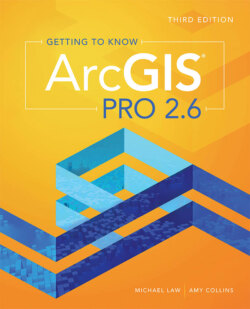Читать книгу Getting to Know ArcGIS Pro 2.6 - Michael Law - Страница 9
What is a GIS?
ОглавлениеProbably the most commonly asked question to those working in the geographic information system (GIS) field is also one of the most difficult to answer in just a few brief paragraphs: What is a GIS? A GIS is composed of five interacting parts that include hardware, software, data, procedures, and people. You are likely already familiar with the hardware—computers, smartphones, and tablets. The software consists of applications that help make maps. The data is information in the form of points, lines, and polygons that you see on a map. People, users like you, learn how to collect data using mobile devices and then make maps using the software and data on computers. As your knowledge of GIS grows, you will learn more about procedures and workflows to make maps for yourself or your organization. Decision-makers and others in an organization rely on GIS staff to maintain data and create insightful map products.
GIS has many facets. It captures, stores, and manages data. It allows you to visualize, question, analyze, and interpret the data to understand relationships, patterns, and trends. GIS can be used simply for mapping and cartography. You can use it on the web to view maps and collections of data. You can also use it to perform spatial analysis to derive information from multiple data sources. In any capacity, the results from a GIS can influence decisions. Organizations in almost every industry, no matter what size, benefit from GIS and realize its value.
Collecting spatial data—that is, information that represents real-world locations and the shapes of geographic features and the relationships between them—involves using coordinates and a suitable map projection to reference this data to the earth. For example, the distance that separates a conservation area and a neighborhood of a city is an example of a spatial relationship. How is wildlife in the conservation area affected by the increasing pressures of a growing urban setting? The spatial relationship between geographic features allows the comparison of different types of data.
When paired with attribute data—information about spatial data—a GIS becomes a powerful tool. For example, the location of a hospital is considered the spatial data (referenced to the earth). Information about the hospital, such as its name, number of rooms available, emergency rooms, specialization in medical procedures, patient capacity, and number of staff, is all considered attribute data. You can use this attribute information to maintain records in a hospital network. It allows people who have that information to perform spatial analysis—a technique that reveals patterns and trends—to answer the following types of questions: What are the average wait times for emergency visits to the hospital? Does the patient capacity efficiently serve the demographics of a given city area? Do certain medical conditions happen more frequently in the area, and is the hospital equipped to handle them? To answer these questions fully, you must compare the data and attempt to explain the patterns. A children’s hospital can integrate spatial analysis with population-based resource planning to propose children’s health-care initiatives. This integration can greatly increase the hospital’s ability to identify and allocate resources to better meet local health-care needs, providing timely access to care for children across a city or region.
